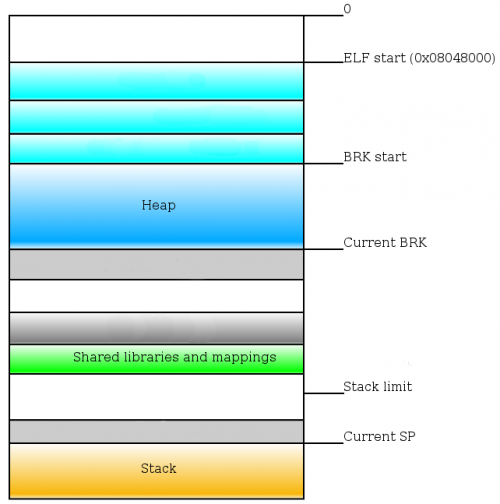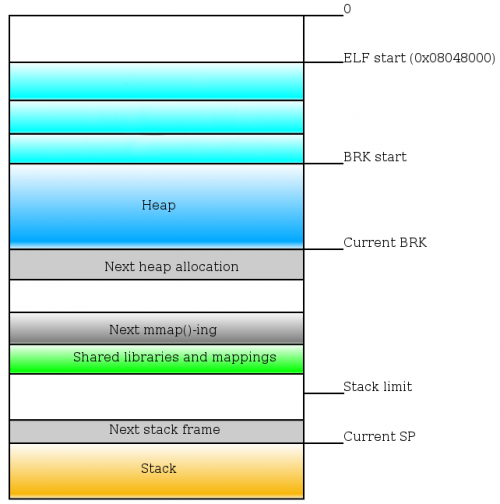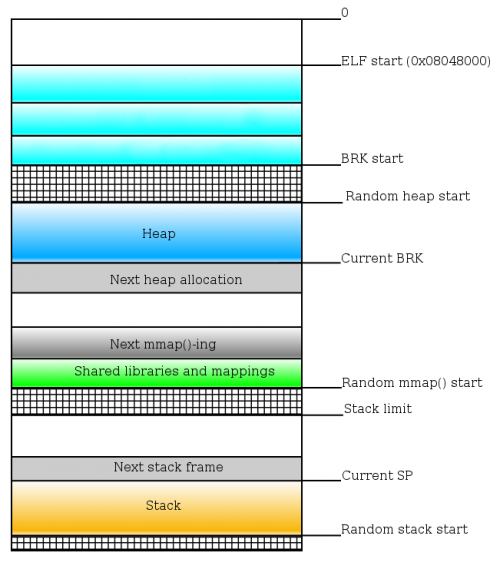Table of Contents
0x02. Executable File Formats
Resources
Tutorials
This session is meant to be a quick intro into how ELF files are structured from the perspective of how it all fits into creating a process. We will also analyze how the ELF structure evolves when going from object file to executable or shared library as well as how various elements get interpreted by the linker and the OS loader. After this we explore how the process looks like once it is loaded in memory as well as some basic runtime analysis principles.
We will first begin with a brief taxonomy of ELF files as well as how they are created from C source files. We will continue with the main elements that constitute an ELF file as well as how they fit in when it comes to executable files. We will then move on to explore in depth each relevant structure with a key focus on how it all goes in to the running process.
Big Picture view
Sun Microsystems' SunOS came up with the concept of dynamic shared libraries and introduced it to UNIX in the late 1980s. UNIX System V Release 4, which Sun co-developed, introduced the ELF object format adaptation from the Sun scheme. Later it was developed and published as part of the ABI (Application Binary Interface) as an improvement over COFF, the previous object format and by the late 1990s it had become the standard for UNIX and UNIX-like systems including Linux and BSD derivatives. Depending on processor architectures, several specifications have emerged with minor changes, but for this session we will be focusing on the ELF-32 format.
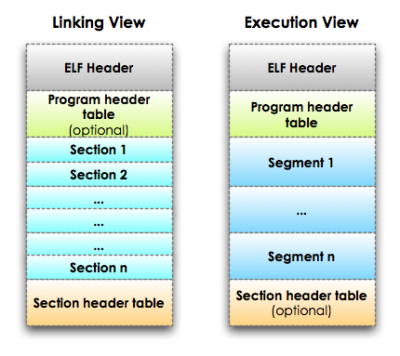
The structure of the ELF file during linking is much the same as when we are referring to object files. On the right hand side we can see how the the ELF file structure will be transformed in memory.
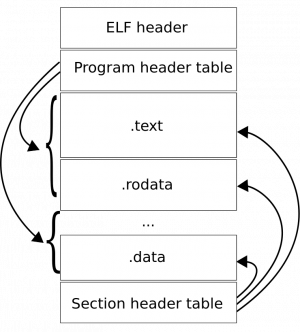
As we can see, the information inside the two program headers and the section headers gets merged as needed inside the more familiar program segments. The basic role for the ELF file format is to serve as a road-map for the linker and the OS Loader to generate a running process.
Static/Dynamic linking
Out of practical considerations, for very large programs, even early on, it was very impractical to store all of the source code inside a single file. One of the most mundane of all actions, namely splitting your source code into functions across multiple files while still obtaining a valid running program was a difficult engineering challenge. The initial paradigm was called static linking and was the only option inside the COFF file format. It involves interpreting each piece of code from each file and then merging all the information inside a single binary that would contain all the machine code necessary for the program. This way of doing things, still in use today, involves loading all of the code and data into memory regardless of use case. This basically meant that, the required resources to run a program were determined by the number of instances, with no possibility of optimization.
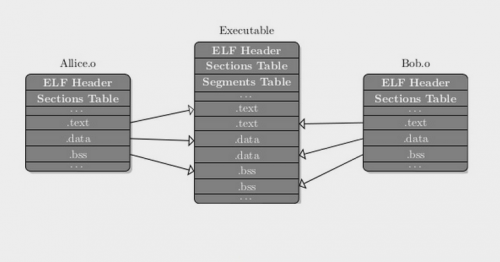
Along with the ELF format came a new way of doing things. Instead of linking all the source files that contained subroutines into the final binaries, separate binaries were organized in libraries that could be loaded per use case, on demand. Essentially, the libraries were loaded only once into memory and when a program instance required a subroutine from a specific library it would inquire a special OS component about it and new resources would be allocated only for the volatile parts of the library image (.bss and .data). The new process allowed for a much more efficient resource utilization and was named dynamic linking and the new type of library files were called shared objects.
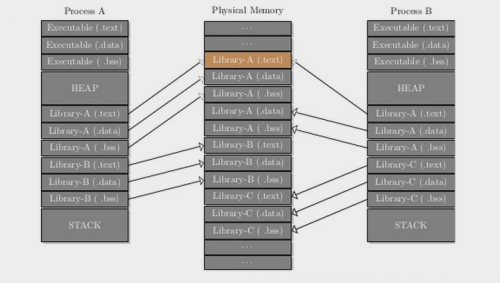
ELF Types
There are several ELF types but the most common types we will be dealing with are:
- Relocatable Files
- Executable Files
- Shared Objects
Relocatable Files
Relocatable files are obtained using the core compiler and basically contain all the ELF information necessary except for data like external variables or subroutines that are present in other files
gcc -c -o reloc.o source.c gcc -c -fPIC -o reloc.o source.c
The first command will produce a relocatable file that will later constitute an executable or a static library. If we want to use the relocatable file to later create a shared library we need to use the second variant to create a relocatable file that has position independent code(PIC)
Shared Objects
Shared libraries are loaded up at runtime as needed by an OS component named the dynamic loader. Shared objects may include other shared objects and this aspect is very important because, when loading specific subroutines, the ELF file must provide its dependencies. As such, the process of dynamic linking does a breadth first search gradually building the full dependency list.
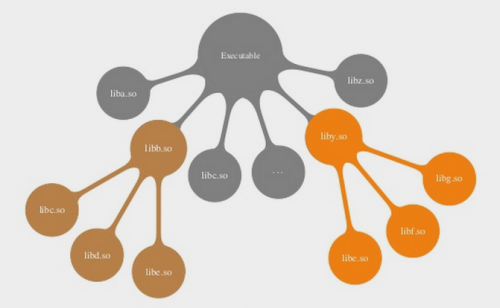
You can view the list of shared object dependencies for any given binary as well as the addresses where they will be loaded in memory by using the ldd command.
ldd /bin/ls linux-gate.so.1 => (0x00e02000) librt.so.1 => /lib/tls/i686/cmov/librt.so.1 (0x004f9000) libselinux.so.1 => /lib/libselinux.so.1 (0x00c62000) libacl.so.1 => /lib/libacl.so.1 (0x00a87000) libc.so.6 => /lib/tls/i686/cmov/libc.so.6 (0x00110000) libpthread.so.0 => /lib/tls/i686/cmov/libpthread.so.0 (0x00325000) /lib/ld-linux.so.2 (0x00a45000) libdl.so.2 => /lib/tls/i686/cmov/libdl.so.2 (0x0077d000) libattr.so.1 => /lib/libattr.so.1 (0x00dd7000)
All libraries should adhere to a strict naming convention. Shared objects have two names:
- soname - that consists of the prefix lib followed by the library name, a .so , another dot, then the major version (ex:libtest.so.1)
- real name - is actually a file name, that usually adds a dot and minor version number along with the release version (ex: libtest.so.1.23.3)
Additionally, each library source file should have an accompanying header file with the extension .h and the same name.
Adhering to these naming conventions is quite important as dependencies are resolved based on the soname.
gcc -c -fPIC libtesting.c ld -shared -soname libtesting.so.1 -o libtesting.so.1.0 -lc libtesting.o ldconfig -v -n . ln -sf libtesting.so.1 libtesting.so export LD_LIBRARY_PATH=.:"$LD_LIBRARY_PATH" gcc -o main_program main_program.c -L. -ltesting
The first line creates an object file with position independent code. The second line will create the shared object with soname “libtesting.so.1” and a real file name of “libtesting.so.1.0” by using the linker. Shared objects are usually installed in other directories but the line containing ldconfig, will install it in the current directory. At runtime the standard directories like /usr/lib are searched, but we add the local directory to the search path by modifying the LD_LIBRARY_PATH environment variable.
Finally, the executable is created by dynamic linking against the shared object.
Executable files
They are regarded as the end result and contain all the information necessary to create a running process.
ELF Structure
- The chapters on ELF structure are not meant to be known by heart, don't try and read them all in one breath, but rather use them as a reference for the exercises
Tools of the trade
Because IDA is expensive and rarely found on machines you just hacked
ELF Header
readelf -h program ELF Header: Magic: 7f 45 4c 46 01 01 01 00 00 00 00 00 00 00 00 00 Class: ELF32 Data: 2's complement, little endian Version: 1 (current) OS/ABI: UNIX - System V ABI Version: 0 Type: EXEC (Executable file) Machine: Intel 80386 Version: 0x1 Entry point address: 0x8048330 Start of program headers: 52 (bytes into file) Start of section headers: 4392 (bytes into file) Flags: 0x0 Size of this header: 52 (bytes) Size of program headers: 32 (bytes) Number of program headers: 8 Size of section headers: 40 (bytes) Number of section headers: 30 Section header string table index: 27
Below we will discuss the less evident aspects of the above output
- Elf Identification (16 bytes)
- Magic - the first bytes of the binary that identify the file as ELF
- Class - identifies the type of ELF ( ex: ELF-32, ELF-64)
- Data - specifies the type of data encoding
- Version - version of the ELF header
- OS/ABI - version of the OS
- ABI - version of the ABI specification
- Type - Relocatable, Executable, Shared Object
- Machine - Required Machine architecture to run the executable
- Entry point address - the memory address where the OS loader transfers control to the process code for the first time.
- Start of Program Headers - File offset where the array of program headers start
- Start of Section Headers - File offset where the array of section headers starts
- Section Header String Table index - the index in the section table name where the information about the section name string table can be found
Program Headers
These are only present inside executable and shared object files
readelf -l program
Elf file type is EXEC (Executable file)
Entry point 0x8048330
There are 8 program headers, starting at offset 52
Program Headers:
Type Offset VirtAddr PhysAddr FileSiz MemSiz Flg Align
PHDR 0x000034 0x08048034 0x08048034 0x00100 0x00100 R E 0x4
INTERP 0x000134 0x08048134 0x08048134 0x00013 0x00013 R 0x1
[Requesting program interpreter: /lib/ld-linux.so.2]
LOAD 0x000000 0x08048000 0x08048000 0x004e4 0x004e4 R E 0x1000
LOAD 0x000f0c 0x08049f0c 0x08049f0c 0x00108 0x00110 RW 0x1000
DYNAMIC 0x000f20 0x08049f20 0x08049f20 0x000d0 0x000d0 RW 0x4
NOTE 0x000148 0x08048148 0x08048148 0x00044 0x00044 R 0x4
GNU_STACK 0x000000 0x00000000 0x00000000 0x00000 0x00000 RW 0x4
GNU_RELRO 0x000f0c 0x08049f0c 0x08049f0c 0x000f4 0x000f4 R 0x1
Section to Segment mapping:
Segment Sections...
00
01 .interp
02 .interp .note.ABI-tag .note.gnu.build-id .hash .gnu.hash .dynsym .dynstr .gnu.version .gnu.version_r .rel.dyn .rel.plt .init .plt .text .fini .rodata .eh_frame
03 .ctors .dtors .jcr .dynamic .got .got.plt .data .bss
04 .dynamic
05 .note.ABI-tag .note.gnu.build-id
06
07 .ctors .dtors .jcr .dynamic .got
The program header table features an array of structures that shows how parts of the file will be mapped into memory at runtime. The last parts of the output show what sections will be merged into various program headers before loading the ELF into memory and becoming segments
- Type
- PHDR - information about the program header table itself
- INTERP - information about the null terminated string that specifies the path to the dynamic loader. This header is only present in executable that use shared object code
- LOAD - use to specify a general purpose loadable segment
- DYNAMIC - information necessary to the dynamic linking process
- Offset - offset from the beginning of the file where the segment begins
- VirtAddr - the address where the segment will start in memory
- FileSz - number of bytes occupied by the segment on disk
- MemSiz - number of bytes occupied by the segment in memory
- Align - specifies a boundary to which the segments are aligned on file and in memory
Section Table
Section headers are the central piece of reference used to organize the ELF files both on disk and in memory.
readelf -S program There are 30 section headers, starting at offset 0x1128: Section Headers: [Nr] Name Type Addr Off Size ES Flg Lk Inf Al [ 0] NULL 00000000 000000 000000 00 0 0 0 [ 1] .interp PROGBITS 08048134 000134 000013 00 A 0 0 1 [ 2] .note.ABI-tag NOTE 08048148 000148 000020 00 A 0 0 4 [ 3] .note.gnu.build-i NOTE 08048168 000168 000024 00 A 0 0 4 [ 4] .hash HASH 0804818c 00018c 000028 04 A 6 0 4 [ 5] .gnu.hash GNU_HASH 080481b4 0001b4 000020 04 A 6 0 4 [ 6] .dynsym DYNSYM 080481d4 0001d4 000050 10 A 7 1 4 [ 7] .dynstr STRTAB 08048224 000224 00004c 00 A 0 0 1 [ 8] .gnu.version VERSYM 08048270 000270 00000a 02 A 6 0 2 [ 9] .gnu.version_r VERNEED 0804827c 00027c 000020 00 A 7 1 4 [10] .rel.dyn REL 0804829c 00029c 000008 08 A 6 0 4 [11] .rel.plt REL 080482a4 0002a4 000018 08 A 6 13 4 [12] .init PROGBITS 080482bc 0002bc 000030 00 AX 0 0 4 [13] .plt PROGBITS 080482ec 0002ec 000040 04 AX 0 0 4 [14] .text PROGBITS 08048330 000330 00017c 00 AX 0 0 16 [15] .fini PROGBITS 080484ac 0004ac 00001c 00 AX 0 0 4 [16] .rodata PROGBITS 080484c8 0004c8 000015 00 A 0 0 4 [17] .eh_frame PROGBITS 080484e0 0004e0 000004 00 A 0 0 4 [18] .ctors PROGBITS 08049f0c 000f0c 000008 00 WA 0 0 4 [19] .dtors PROGBITS 08049f14 000f14 000008 00 WA 0 0 4 [20] .jcr PROGBITS 08049f1c 000f1c 000004 00 WA 0 0 4 [21] .dynamic DYNAMIC 08049f20 000f20 0000d0 08 WA 7 0 4 [22] .got PROGBITS 08049ff0 000ff0 000004 04 WA 0 0 4 [23] .got.plt PROGBITS 08049ff4 000ff4 000018 04 WA 0 0 4 [24] .data PROGBITS 0804a00c 00100c 000008 00 WA 0 0 4 [25] .bss NOBITS 0804a014 001014 000008 00 WA 0 0 4 [26] .comment PROGBITS 00000000 001014 000023 01 MS 0 0 1 [27] .shstrtab STRTAB 00000000 001037 0000ee 00 0 0 1 [28] .symtab SYMTAB 00000000 0015d8 000410 10 29 45 4 [29] .strtab STRTAB 00000000 0019e8 0001fd 00 0 0 1
- Name - is obtained by reading the value of the section names table at the specified index
- Type
- PROGBITS - information that is given meaning by the program when loaded into memory
- NOBITS - similar to PROGBITS in meaning but occupies no space in the file
- STRTAB - contains the program string table
- SYMTAB - contains the symbol table
- DYNAMIC - holds information necessary for dynamic linking
- DYNSYM - holds a set of symbols used in the dynamic linking process
- REL - holds relocation entries
- Addr - if the section is part of an executable it will hold the virtual address where the section could be found in memory. If not it would be 0.
- Off - offset from the beginning of the file to where the section starts
- Size - size of the section in bytes
- ES - size in bytes per entry, if fixed entry size is used
- FLG
- X - contains executable code
- W - contains writable code
- A - will be loaded into memory as-is during process execution
- Al - section alignment constraints
Inf and Lnk have specific interpretations depending on the section type
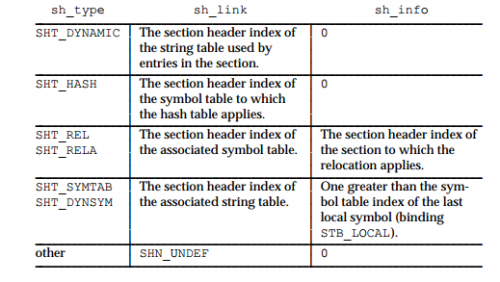
Additionally, the raw contents of each section can be dumped using both objdump and readelf
readelf -x .got program Hex dump of section '.got': 0x08049ff0 00000000 .... objdump -s -j ".got" program program: file format elf32-i386 Contents of section .got: 8049ff0 00000000 ....
readelf you can interpret the output like strings by using the -p flag.
Symbol Table
One of the initial goals of the ELF format was to enable dynamic linking. Given the machine code of a binary, various elements inside it will use absolute addresses that are based on the memory address where the binary expects to be loaded. The entire idea of shared libraries is that these can be loaded and unloaded on demand inside the memory space of whichever process needs them at whichever address is available. As such, a map of how to locate and relocate absolute data points inside the machine code is needed and that's where the symbol table comes in.
readelf -s libtesting.so.1
Symbol table '.dynsym' contains 8 entries:
Num: Value Size Type Bind Vis Ndx Name
0: 00000000 0 NOTYPE LOCAL DEFAULT UND
1: 00001339 1 OBJECT GLOBAL DEFAULT 12 cPub
2: 000001f8 10 FUNC GLOBAL DEFAULT 7 fPub
3: 0000020c 100 FUNC GLOBAL DEFAULT 7 foo
4: 00001328 16 OBJECT GLOBAL DEFAULT 11 a
5: 00001338 0 NOTYPE GLOBAL DEFAULT ABS __bss_start
6: 0000133c 0 NOTYPE GLOBAL DEFAULT ABS _end
7: 00001338 0 NOTYPE GLOBAL DEFAULT ABS _edata
Symbol table '.symtab' contains 27 entries:
Num: Value Size Type Bind Vis Ndx Name
0: 00000000 0 NOTYPE LOCAL DEFAULT UND
1: 000000b4 0 SECTION LOCAL DEFAULT 1
2: 000000e8 0 SECTION LOCAL DEFAULT 2
3: 00000168 0 SECTION LOCAL DEFAULT 3
4: 000001a8 0 SECTION LOCAL DEFAULT 4
5: 000001d0 0 SECTION LOCAL DEFAULT 5
6: 000001d8 0 SECTION LOCAL DEFAULT 6
7: 000001f8 0 SECTION LOCAL DEFAULT 7
8: 00001274 0 SECTION LOCAL DEFAULT 8
9: 00001314 0 SECTION LOCAL DEFAULT 9
10: 00001318 0 SECTION LOCAL DEFAULT 10
11: 00001328 0 SECTION LOCAL DEFAULT 11
12: 00001338 0 SECTION LOCAL DEFAULT 12
13: 00000000 0 SECTION LOCAL DEFAULT 13
14: 00000000 0 FILE LOCAL DEFAULT ABS libtesting.c
15: 00000202 10 FUNC LOCAL DEFAULT 7 fLocal
16: 00001338 1 OBJECT LOCAL DEFAULT 12 cLocal
17: 00001318 0 OBJECT LOCAL HIDDEN ABS _GLOBAL_OFFSET_TABLE_
18: 00000270 0 FUNC LOCAL HIDDEN 7 __i686.get_pc_thunk.bx
19: 00001274 0 OBJECT LOCAL HIDDEN ABS _DYNAMIC
20: 00001339 1 OBJECT GLOBAL DEFAULT 12 cPub
21: 000001f8 10 FUNC GLOBAL DEFAULT 7 fPub
22: 0000020c 100 FUNC GLOBAL DEFAULT 7 foo
23: 00001328 16 OBJECT GLOBAL DEFAULT 11 a
24: 00001338 0 NOTYPE GLOBAL DEFAULT ABS __bss_start
25: 0000133c 0 NOTYPE GLOBAL DEFAULT ABS _end
26: 00001338 0 NOTYPE GLOBAL DEFAULT ABS _edata
Some information on the symbols that may belong to external files or may be referenced by external files during dynamic linking are copied in the .dynsym section
- Name - symbol name
- Type
- NoType - not specified
- FUNC - the symbol influences a function
- SECTION - associated with a section
- FILE - a symbol that references a files
- Bind
- LOCAL - the symbol information is not visible outside the object file
- GLOBAL - the symbol is visible to all the files being combined to form the executable
- Size - the size of the symbol in bytes or 0 if it is unknown
- Ndx
- UND - unspecified section reference
- COM - unallocated C external variable
- ABS - an absolute value for the reference
- value - an index into the section table
- Value - if the symbol table is part of an executable, the value will contain a memory address where the symbol resides. Otherwise it will contain an offset from the beginning of the section referenced by Ndx or O.
As you can see, the symbol table as it appears in object files compiled with gcc is quite verbose, revealing function names and visibility as well as variable scopes, names and even sizes. In its default form it even shows the name of the sourcefile.
- strip is your friend
Relocations
Relocations were a concept that was present ever since the invention of static linking. The initial purpose of relocations was to give the static linker a roadmap when combining multiple object files into a binary by stating:
- the symbol that needs to be fixed
- where you can find the symbol (file/section offset)
- an algorithm for making the fixes
The fixes would usually be made in the .data and .text sections and everything was well. Dynamic runtime brought a bit of a complication to modifications that needed to be made in the code segments. The whole idea of shared libraries is that the code can be loaded once into memory from an ELF file then shared among all the processes that use the library. The only way to reliably do this is to make the code section read-only.
In order to compensate for this constraint a special data section called the GOT (global offset table) was created. When the code needs to work with a symbol that belongs to shared object, in the code entry for that symbol uses addresses from the GOT table. First time the symbol is referenced the dynamic linker corrects the entry in GOT and on subsequent calls the correct address will be used.
When implementing calls to subroutines in shared objects, a different table is used called the PLT (procedure linkage table). The initial call is made to a stub sequence in the PLT which bounces off a GOT entry in order to push the subroutine name on the stack and then calls the resolver (mentioned in the INTERP program header).
readelf -r libdynamic.o Relocation section '.rel.text' at offset 0x5f8 contains 8 entries: Offset Info Type Sym.Value Sym. Name 0000001d 00001402 R_386_PC32 00000000 __i686.get_pc_thunk.bx 00000023 0000150a R_386_GOTPC 00000000 _GLOBAL_OFFSET_TABLE_ 00000029 00000409 R_386_GOTOFF 00000000 .bss 0000002f 00000409 R_386_GOTOFF 00000000 .bss 00000035 00000d03 R_386_GOT32 00000004 so_int_global 00000041 00000d03 R_386_GOT32 00000004 so_int_global 00000052 00000e04 R_386_PLT32 00000000 so_fpublic_global 0000005b 00000209 R_386_GOTOFF 00000000 .text Relocation section '.rel.data.rel.local' at offset 0x638 contains 2 entries: Offset Info Type Sym.Value Sym. Name 00000000 00000401 R_386_32 00000000 .bss 00000004 00000201 R_386_32 00000000 .text Relocation section '.rel.data.rel' at offset 0x648 contains 2 entries: Offset Info Type Sym.Value Sym. Name 00000000 00000d01 R_386_32 00000004 so_int_global 00000004 00000e01 R_386_32 00000000 so_fpublic_global
- Offset - In relocatable files and linked shared objects it contains the offset from the beginning of the section , where the relocation needs to be applied
- Info - This field is used to derive the index in the symbol table to the affected symbol as well as the algorithm needed for fixing.
- info»8 - symbol table index
- info&0xff - algorithm type as defined in the documentation
readelf is nice enough to interpret the symbol table for us and gives us the relocation algorithm in the Type field and also the symbol name and value as defined in the symbol table
By looking at the types of relocations we can draw some basic conclusions about the symbol types and also about the files.
- Reloctable Files
- R_386_32 - usually used to reference changes to a local symbol
- R_386_PC32 - reference a relative distance from here to the symbol
- Relocatable Files for Shared object
- R_386_GOTOFF - usually found in the code area, describes the offset from the beginning of GOT to a local symbol
- R_386_GOT32 - also speicific to the code area. These entries persist in the linkage phase
- R_386_PLT32 - used when describing calls to global subroutines. when the linker will read this information it will generate an entry in the GOT and PLT tables
- R_386_GOTPC - used in function to calculate the start address of the GOT
- Executables that use dynamic linking
- R_386_JMP - the dynamic linker will deposit the address of the external subroutine during execution
- R_386_COPY - the address of global variable from shared object will be deposited here
- Shared object files
- R_386_JMP - the dynamic linker will deposit the address of the external subroutine from one of the shared object dependencies during execution
- R_386_GLOB_DATA - used to deposit the address of a global symbol defined in one of the shared object dependencies
- R_386_RELATIVE - at link time all the R_386_GOTOFF entries are fixed and these relocation will contain absolute addresses
- Executable files that are statically linked do not contain relocations
Memory layout
To understand the full picture of program execution it is vital to understand the memory layout of processes from ELF executables. The kernel provides an interface in /proc/<PID>/maps for each process to see how the memory layout looks like.
Let's write a simple Hello World application and investigate.
#include <stdio.h> int main() { printf("Hello world\n"); malloc(10000); while(1){ ; } return 0; }
$ gcc -Wall hw.c -o hw -m32 $ ./hw & [1] 4771 Hello world $ cat /proc/4771/maps 08048000-08049000 r-xp 00000000 08:06 1843771 /tmp/hw 08049000-0804a000 r--p 00000000 08:06 1843771 /tmp/hw 0804a000-0804b000 rw-p 00001000 08:06 1843771 /tmp/hw 0804b000-0806e000 rw-p 00000000 00:00 0 [heap] f7ded000-f7dee000 rw-p 00000000 00:00 0 f7dee000-f7f93000 r-xp 00000000 08:06 917808 /lib32/libc-2.17.so f7f93000-f7f95000 r--p 001a5000 08:06 917808 /lib32/libc-2.17.so f7f95000-f7f96000 rw-p 001a7000 08:06 917808 /lib32/libc-2.17.so f7f96000-f7f99000 rw-p 00000000 00:00 0 f7fd9000-f7fdb000 rw-p 00000000 00:00 0 f7fdb000-f7fdc000 r-xp 00000000 00:00 0 [vdso] f7fdc000-f7ffc000 r-xp 00000000 08:06 917869 /lib32/ld-2.17.so f7ffc000-f7ffd000 r--p 0001f000 08:06 917869 /lib32/ld-2.17.so f7ffd000-f7ffe000 rw-p 00020000 08:06 917869 /lib32/ld-2.17.so fffdd000-ffffe000 rw-p 00000000 00:00 0 [stack]
If we start another process in the background the output for it will be exactly the same as this one. Why is that? The answer, of course, is virtual memory. The kernel provides this mechanism through which each process has an address space completely isolated from that of other running processes. They can still communicate using inter-process communication mechanisms provided by the kernel but we won't get into that here.
An initial schematic of the memory layout would be the following:
Executable
As we have seen, there are three memory regions associated with the executable:
08048000-08049000 r-xp 00000000 08:06 1843771 /tmp/hw 08049000-0804a000 r--p 00000000 08:06 1843771 /tmp/hw 0804a000-0804b000 rw-p 00001000 08:06 1843771 /tmp/hw
From their permissions we can infer what they correspond to:
08048000-08049000 r-xpis the.textsection along with the rest of the executable parts08049000-0804a000 r–pis the.rodatasection0804a000-0804b000 rw-pconsists of the.data,.bsssections and other R/W sections.
It is interesting to note that the executable is almost identically mapped into memory. The only region that is compressed in the binary is the '.bss' section. Let's see this in action by dumping the header of the file:
$ hexdump -Cv hw | head 00000000 7f 45 4c 46 01 01 01 00 00 00 00 00 00 00 00 00 |.ELF............| 00000010 02 00 03 00 01 00 00 00 b0 83 04 08 34 00 00 00 |............4...| 00000020 78 11 00 00 00 00 00 00 34 00 20 00 0a 00 28 00 |x.......4. ...(.| 00000030 1e 00 1b 00 06 00 00 00 34 00 00 00 34 80 04 08 |........4...4...| 00000040 34 80 04 08 40 01 00 00 40 01 00 00 05 00 00 00 |4...@...@.......| 00000050 04 00 00 00 03 00 00 00 74 01 00 00 74 81 04 08 |........t...t...| 00000060 74 81 04 08 13 00 00 00 13 00 00 00 04 00 00 00 |t...............| 00000070 01 00 00 00 01 00 00 00 00 00 00 00 00 80 04 08 |................| 00000080 00 80 04 08 6c 06 00 00 6c 06 00 00 05 00 00 00 |....l...l.......| 00000090 00 10 00 00 01 00 00 00 00 0f 00 00 00 9f 04 08 |................| $ gdb ./hw ........... gdb-peda$ hexdump 0x08048000 /10 0x08048000 : 7f 45 4c 46 01 01 01 00 00 00 00 00 00 00 00 00 .ELF............ 0x08048010 : 02 00 03 00 01 00 00 00 b0 83 04 08 34 00 00 00 ............4... 0x08048020 : 78 11 00 00 00 00 00 00 34 00 20 00 0a 00 28 00 x.......4. ...(. 0x08048030 : 1e 00 1b 00 06 00 00 00 34 00 00 00 34 80 04 08 ........4...4... 0x08048040 : 34 80 04 08 40 01 00 00 40 01 00 00 05 00 00 00 4...@...@....... 0x08048050 : 04 00 00 00 03 00 00 00 74 01 00 00 74 81 04 08 ........t...t... 0x08048060 : 74 81 04 08 13 00 00 00 13 00 00 00 04 00 00 00 t............... 0x08048070 : 01 00 00 00 01 00 00 00 00 00 00 00 00 80 04 08 ................ 0x08048080 : 00 80 04 08 6c 06 00 00 6c 06 00 00 05 00 00 00 ....l...l....... 0x08048090 : 00 10 00 00 01 00 00 00 00 0f 00 00 00 9f 04 08 ................
Heap
The heap comes right after the executable at 0x0804b000 and ends at 0x0806e000 which is the current brk point. The memory allocator will increase the brk when more allocations are made but will not decrease it when memory is freed so as to reuse the memory regions for future allocations. The allocator in libc actually keeps a list of past allocations and their sizes. When future allocations will require the same size as a previously freed region, the allocator will reuse one from this lookup table. The process is called binning.
Let's see how the brk evolves in our executable using strace:
$ strace -i -e brk ./hw [ Process PID=1995 runs in 32 bit mode. ] [f7ff2314] brk(0) = 0x804b000 Hello world [f7fdb430] brk(0) = 0x804b000 [f7fdb430] brk(0x806e000) = 0x806e000
Let's test the fact that the brk does not decrease and that future malloc's can reuse previously freed regions:
#include <stdio.h> int main() { void * buf[15]; int i; for( i = 0 ; i < 15; i++) buf[i] = malloc( i * 100) ; for( i = 0 ; i < 15; i++) free( buf[i] ); for( i = 0 ; i < 15; i++) buf[i] = malloc( i * 100) ; return 0; }
$ strace -e brk ./hw [ Process PID=2424 runs in 32 bit mode. ] brk(0) = 0x804b000 brk(0) = 0x804b000 brk(0x806c000) = 0x806c000 +++ exited with 0 +++ $ ltrace -e malloc ./hw hw->malloc(0) = 0x804b008 hw->malloc(100) = 0x804b018 hw->malloc(200) = 0x804b080 hw->malloc(300) = 0x804b150 hw->malloc(400) = 0x804b280 hw->malloc(500) = 0x804b418 hw->malloc(600) = 0x804b610 hw->malloc(700) = 0x804b870 hw->malloc(800) = 0x804bb30 hw->malloc(900) = 0x804be58 hw->malloc(1000) = 0x804c1e0 hw->malloc(1100) = 0x804c5d0 hw->malloc(1200) = 0x804ca20 hw->malloc(1300) = 0x804ced8 hw->malloc(1400) = 0x804d3f0 hw->malloc(0) = 0x804b008 hw->malloc(100) = 0x804b018 hw->malloc(200) = 0x804b080 hw->malloc(300) = 0x804b150 hw->malloc(400) = 0x804b280 hw->malloc(500) = 0x804b418 hw->malloc(600) = 0x804b610 hw->malloc(700) = 0x804b870 hw->malloc(800) = 0x804bb30 hw->malloc(900) = 0x804be58 hw->malloc(1000) = 0x804c1e0 hw->malloc(1100) = 0x804c5d0 hw->malloc(1200) = 0x804ca20 hw->malloc(1300) = 0x804ced8 hw->malloc(1400) = 0x804d3f0 +++ exited (status 0) +++
As you can see, only one brk call is made. Furthermore, after the regions are freed they are reused.
Memory mappings and libraries
In our example we had the following memory mappings:
f7ded000-f7dee000 rw-p 00000000 00:00 0 f7dee000-f7f93000 r-xp 00000000 08:06 917808 /lib32/libc-2.17.so f7f93000-f7f95000 r--p 001a5000 08:06 917808 /lib32/libc-2.17.so f7f95000-f7f96000 rw-p 001a7000 08:06 917808 /lib32/libc-2.17.so f7f96000-f7f99000 rw-p 00000000 00:00 0 f7fd9000-f7fdb000 rw-p 00000000 00:00 0 f7fdb000-f7fdc000 r-xp 00000000 00:00 0 [vdso] f7fdc000-f7ffc000 r-xp 00000000 08:06 917869 /lib32/ld-2.17.so f7ffc000-f7ffd000 r--p 0001f000 08:06 917869 /lib32/ld-2.17.so f7ffd000-f7ffe000 rw-p 00020000 08:06 917869 /lib32/ld-2.17.so
All functions that are called from external libraries pull in the whole library into the address space. As these are also ELF files you can see that they have similar patterns: multiple sections with different permissions just like the main executable.
One more thing to note here is that large calls to malloc result in calls to 'mmap2':
#include <stdio.h> int main() { printf("Hello world\n"); printf("Small allocation %p\n", malloc(10000)); printf("Big allocation %p\n", malloc(10000000)); return 0; }
# strace -e brk,mmap2 ./hw_large [ Process PID=3445 runs in 32 bit mode. ] brk(0) = 0x804b000 mmap2(NULL, 4096, PROT_READ|PROT_WRITE, MAP_PRIVATE|MAP_ANONYMOUS, -1, 0) = 0xfffffffff7fda000 mmap2(NULL, 265183, PROT_READ, MAP_PRIVATE, 3, 0) = 0xfffffffff7f99000 mmap2(NULL, 1747628, PROT_READ|PROT_EXEC, MAP_PRIVATE|MAP_DENYWRITE, 3, 0) = 0xfffffffff7dee000 mmap2(0xf7f93000, 12288, PROT_READ|PROT_WRITE, MAP_PRIVATE|MAP_FIXED|MAP_DENYWRITE, 3, 0x1a5000) = 0xfffffffff7f93000 mmap2(0xf7f96000, 10924, PROT_READ|PROT_WRITE, MAP_PRIVATE|MAP_FIXED|MAP_ANONYMOUS, -1, 0) = 0xfffffffff7f96000 mmap2(NULL, 4096, PROT_READ|PROT_WRITE, MAP_PRIVATE|MAP_ANONYMOUS, -1, 0) = 0xfffffffff7ded000 mmap2(NULL, 4096, PROT_READ|PROT_WRITE, MAP_PRIVATE|MAP_ANONYMOUS, -1, 0) = 0xfffffffff7fd9000 Hello world brk(0) = 0x804b000 brk(0x806e000) = 0x806e000 Small allocation 0x804b008 mmap2(NULL, 10002432, PROT_READ|PROT_WRITE, MAP_PRIVATE|MAP_ANONYMOUS, -1, 0) = 0xfffffffff7463000 Big allocation 0xf7463008
As expected, the brk is increased when the first allocation is made. However, larger regions are backed by memory mappings.
Stack
If you observed from previous traces, the mmap2 call returns addresses towards NULL (lower addresses). It behaves like this because there is another important memory region called the stack that has a fixed size: usually 8 MB. Since the heap and the mmap region do not have this limit imposed the optimization is to start mmap-ings from a known boundary: the stack end boundary. Let's put this into perspective. You can view the current stack limit using ulimit -s
$ ulimit -s 8192 $ python >>> hex(0xffffffff - 8192*1024) '0xff7fffff'
This address is the stack boundary. It seems odd then that the first mmap in the program above ends at 0xf7ffe000 and not 0xff7fffff. This is probably an optimization.
However, we can set the stack size to unlimited and the mmap allocation direction will reverse:
$ ulimit -s unlimited $ strace -e mmap2,brk ./hw_large [ Process PID=4617 runs in 32 bit mode. ] brk(0) = 0x804b000 mmap2(NULL, 4096, PROT_READ|PROT_WRITE, MAP_PRIVATE|MAP_ANONYMOUS, -1, 0) = 0x55578000 mmap2(NULL, 265183, PROT_READ, MAP_PRIVATE, 3, 0) = 0x55579000 mmap2(NULL, 1747628, PROT_READ|PROT_EXEC, MAP_PRIVATE|MAP_DENYWRITE, 3, 0) = 0x555ba000 mmap2(0x5575f000, 12288, PROT_READ|PROT_WRITE, MAP_PRIVATE|MAP_FIXED|MAP_DENYWRITE, 3, 0x1a5000) = 0x5575f000 mmap2(0x55762000, 10924, PROT_READ|PROT_WRITE, MAP_PRIVATE|MAP_FIXED|MAP_ANONYMOUS, -1, 0) = 0x55762000 mmap2(NULL, 4096, PROT_READ|PROT_WRITE, MAP_PRIVATE|MAP_ANONYMOUS, -1, 0) = 0x55765000 mmap2(NULL, 4096, PROT_READ|PROT_WRITE, MAP_PRIVATE|MAP_ANONYMOUS, -1, 0) = 0x55579000 Hello world brk(0) = 0x804b000 brk(0x806e000) = 0x806e000 Small allocation 0x804b008 mmap2(NULL, 10002432, PROT_READ|PROT_WRITE, MAP_PRIVATE|MAP_ANONYMOUS, -1, 0) = 0x55766000 Big allocation 0x55766008 ^Z [1]+ Stopped strace -e mmap2,brk ./hw_large $ cat /proc/4617/maps 08048000-08049000 r-xp 00000000 08:06 1843771 /tmp/hw_large 08049000-0804a000 r--p 00000000 08:06 1843771 /tmp/hw_large 0804a000-0804b000 rw-p 00001000 08:06 1843771 /tmp/hw_large 0804b000-0806e000 rw-p 00000000 00:00 0 [heap] 55555000-55575000 r-xp 00000000 08:06 917869 /lib32/ld-2.17.so 55575000-55576000 r--p 0001f000 08:06 917869 /lib32/ld-2.17.so 55576000-55577000 rw-p 00020000 08:06 917869 /lib32/ld-2.17.so 55577000-55578000 r-xp 00000000 00:00 0 [vdso] 55578000-5557a000 rw-p 00000000 00:00 0 555ba000-5575f000 r-xp 00000000 08:06 917808 /lib32/libc-2.17.so 5575f000-55761000 r--p 001a5000 08:06 917808 /lib32/libc-2.17.so 55761000-55762000 rw-p 001a7000 08:06 917808 /lib32/libc-2.17.so 55762000-560f0000 rw-p 00000000 00:00 0 fffdd000-ffffe000 rw-p 00000000 00:00 0 [stack]
As you can see, the big allocation is now towards the stack instead of towards the heap.
Returning to the main functionality of the stack, remember from the previous lab that local variables are declared on the stack. This translates into assembly code in the following way:
int main() { char buf[1000]; int i; ............ }
0804840c <main>: 804840c: 55 push ebp 804840d: 89 e5 mov ebp,esp 804840f: 81 ec f0 03 00 00 sub esp,0x3f0 ..........
0x3f0 is equal to 1008 which is precisely 1000 (from buf) + 4 (from i) + 4 (the storage of another int that the compiler used later in the code)
As the program subtracts more from esp the kernel will provide pages on-demand until the stack boundary or another mmap-ing is hit. The kernel will, in this case, kill the application because of the Segmentation Fault.
Segmentation Fault
Now that we know everything about the memory address space we can say more about the infamous Segmentation Fault that all of us have, at some time, encountered. It is basically a permission violation. Apart from the mappings that appear in /proc/<PID>/maps with r--, rw-, etc, you can consider that everything else is ---. Thus, a read access at such a location will violate the permission of that region so the whole app will be killed by the signal received (unless it has a signal handler). Examples:
- dereferencing a NULL pointer will try to read from 0x00000000 which is not (usually) mapped ⇒ SIGSEGV (read access on none)
- writing after the end of a heap buffer (if the heap buffer is exactly at the end of a mapping) will determine writes into unmapped pages ⇒ SIGSEGV (write access on none)
- trying to write to .rodata ⇒ (write access on read only)
- overwriting the stack with “AAAAAAAAAAAAAAAAAAA” will also overwrite the return address and make the execution go to 0x41414141 ⇒ SIGSEGV (execute access on none)
- overwriting the stack and return address with another address to a shellcode on the stack ⇒ SIGSEGV (execute access on read/write only)
- trying to rewrite the binary ( int *v = main; *v = 0x90909090; ) ⇒ SIGSEGV (write access on read/execute only)
Pure 32-bit systems
Until now, the listings have been from a 32-bit binary running on a 64-bit platform. As you have seen, the stack reaches towards 0xffffffff. On 32-bit systems we don't have this luxury as the memory address space is split:
- 0x00000000 - 0xbfffffff ⇒ user-space
- 0xc0000000 - 0xffffffff ⇒ kernel-space
So, the stack will begin at around 0xbfffffff. Let's test this out using one of the binaries. The new memory layout will look like this:
08048000-08049000 r-xp 00000000 08:06 1843771 /tmp/hw_large 08049000-0804a000 r--p 00000000 08:06 1843771 /tmp/hw_large 0804a000-0804b000 rw-p 00001000 08:06 1843771 /tmp/hw_large 0804b000-0806e000 rw-p 00000000 00:00 0 [heap] b7465000-b7df0000 rw-p 00000000 00:00 0 b7df0000-b7f95000 r-xp 00000000 08:06 917808 /lib32/libc-2.17.so b7f95000-b7f97000 r--p 001a5000 08:06 917808 /lib32/libc-2.17.so b7f97000-b7f98000 rw-p 001a7000 08:06 917808 /lib32/libc-2.17.so b7f98000-b7f9b000 rw-p 00000000 00:00 0 b7fdb000-b7fdd000 rw-p 00000000 00:00 0 b7fdd000-b7fde000 r-xp 00000000 00:00 0 [vdso] b7fde000-b7ffe000 r-xp 00000000 08:06 917869 /lib32/ld-2.17.so b7ffe000-b7fff000 r--p 0001f000 08:06 917869 /lib32/ld-2.17.so b7fff000-b8000000 rw-p 00020000 08:06 917869 /lib32/ld-2.17.so bffdf000-c0000000 rw-p 00000000 00:00 0 [stack]
Summary of memory layout without ASLR
Address Space Layout Randomization
In practice, you will find that memory mappings are not that static. Actually, most of the offsets might seem to vary at each new run of a binary. This is a security feature and we will talk about the motives that introduced it in a future lab.
For the moment you should only need to know that the heap, the stack and the mmap areas are randomized by the kernel introducing an initial random offset:
This randomization can be controlled through parameters passed to the kernel. The file /proc/sys/kernel/randomize_va_space provides this interface. You can read from it or write the following values:
- 0 ⇒ no randomization (that is what we used for the previous listings in this memory layout tutorial)
- 1 ⇒ stack randomization
- 2 ⇒ stack, heap and mmap randomization
Challenges
01. Binary Puzzle
Now that you know some stuff let's see how fast you can solve a 4 piece puzzle!
You are given 4 relocatable object files. Examine their structure carefully and figure out what each of them is meant to be and how you can link them to create a valid binary.
All conventions regarding shared object names have been respected.
nm to investigate the files, determine what pieces you need to put together and then link them with gcc.
gcc command.
If you do it correctly you will get an executable that you can run and get the following output:
Congratulations extern var1 10 at 0x565fe020 extern var2 at 0x565fe030 extern var3 99 at 0x565fe024 local var4 0 at 0xffd532ac g(): not really external
02. Case of the Missing Function
This task contains a helpless little binary that has lost one of its functions. Analyze the symbol dependencies as well as the code inside the binary. Figure out a way to reunite the binary with its missing function.
You cannot modify any of the binaries in order to solve this task.
Use nm to determine what symbols should be part of the missing component.
LD_LIBRARY_PATH=. to run an executable file and load a shared library file from the current folder.
03. Memory Dump Analysis
Using your newfound voodoo skills you are now able to tackle the following task. In the middle of two programs I added the following lines:
{ int i; int *a[1]; for( i = 0 ; i < 20; i++) printf("%p\n", a[i]); }
The results were the following. respectively:
0x804853b 0x1 0x8048530 (nil) (nil) 0xf7e0ace5 0x1 0xffffce64 0xffffce6c 0xf7ffcfc0 0x1c (nil) 0xf7fda4c8 0x2 0xffffce60 0xf7f94e54 (nil) (nil) (nil) 0xd545cf8d
and
0xbfffe7d0 0xd696910 0x80484a9 0xb7fffbe8 0x3 0xb7ffefc0 0xb7df6a84 0x1 0xb7fdc780 0xb7fe75fc 0x804c008 0xb7e59195 0x804c008 0xb7fdb000 0xb7fdc000 0x1 0xffffffff 0x3 (nil) 0xf3b9a5b
Try to tell:
- which was running on a pure 32 bit system
- which values from the stack traces are from the .text region
- which do not point to valid memory addresses
- which point to the stack
- which point to the library/mmap zone
04. Compiler Flags
Use proper compiler/linker flags/options to create a running executable for flag1.o and caller.c and for flag2.o and caller.c. Submit the flag on the platform.
flag*.o object files.
05. Print Flag
Someone has tampered with the executable file get_message. Please fix this. There should be a flag message printed in case you solve it correctly.
06. Matryoshka
Look carefully inside the matryoshka executable. The flag is there, but inside something else.
Submit the flag on the platform.
Bonus: 07. Fix Me
You are given a binary that was stored on a USB stick in space where it was hit by gamma rays thus altering its content. Fortunately, because the executable is so small, the only area damaged is the ELF header. Fix it and run it!
0x8048054
Further pwning
http://crackmes.cf/users/geyslan/crackme.02.32/ is a challenge that will test your knowledge from the first three sessions. The password for the archive is 'crackmes.de'.

